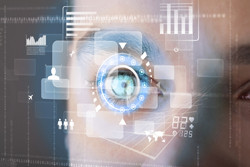Capturing eyes and faces from afar
Biometric identification represents an important innovation in furthering security, but suffers from low adoption rates due to a variety of reasons, from technological barriers to public discomfort. Now, the advent of biometrics 'on the move' is promising to capture biometric data from a distance, reducing user cooperation and intrusiveness. The EU-funded project 'Biometrics at a distance' (BIO-DISTANCE) investigated ways to improve biometric technology applications in such contexts. Focusing on the face and iris as the most promising for developing distance biometrics, the project team worked on different software challenges and technical objectives. It studied face and iris quality measures such as motion blur, iris boundaries and occlusion. Another challenge involved developing face and iris detection and segmentation algorithms that help recognise the eye or face even from a long distance. As the iris is a small area that is very difficult to capture, the team focused instead on the whole eye area as an intermediary step to achieving its final goals. After investigating detection of human faces over large distances, even in cases where the iris texture cannot be captured, the project team made progress in advanced feature extraction and matching algorithms. Much work was done on periocular recognition — i.e. around the eyes, including eyelids, lashes and brows. This led to examining the prospect of multi-biometric recognition, fusing the more accurate iris recognition with the relatively new field of periocular identification for even better results. Research conducted within the BIO-DISTANCE project is destined to be useful in a number of applications, particularly where screening a large number of people unobtrusively is desired. This could include travellers moving through security checkpoints or to control access to buildings. The project's work will encourage better recognition capabilities in surveillance camera systems and further security in several ways. Beyond security, the technology could be used in human–computer interaction and in-car applications such as pedestrian collision avoidance and driver drowsiness detection, as well as in lip reading and robotics. Security, safety and automation all stand to gain from this ambitious initiative.
Keywords
Eyes, faces, public spaces, biometric science, biometric identification, security, technological barriers, iris, feature extraction, periocular recognition, multi-biometric recognition, surveillance camera

